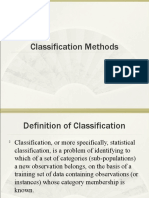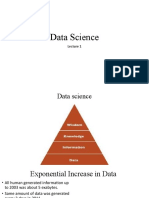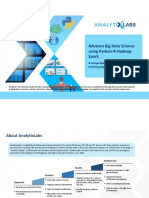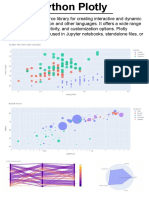ML Project - Jupyter Notebook
Uploaded by
JAISURYA S B.Sc.AIDAML Project - Jupyter Notebook
Uploaded by
JAISURYA S B.Sc.AIDA1/25/23, 9:10 AM ml project - Jupyter Notebook
In [1]:
import pandas as pd
df=pd.read_csv("C:\\Users\\DELL\\OneDrive\\Desktop\\computer network\\deliverytime.txt")
df
Out[1]:
ID Delivery_person_ID Delivery_person_Age Delivery_person_Ratings Restaurant_latitude Restaurant_longitude Delivery_location_la
0 4607 INDORES13DEL02 37 4.9 22.745049 75.892471 22.7
1 B379 BANGRES18DEL02 34 4.5 12.913041 77.683237 13.0
2 5D6D BANGRES19DEL01 23 4.4 12.914264 77.678400 12.9
3 7A6A COIMBRES13DEL02 38 4.7 11.003669 76.976494 11.0
4 70A2 CHENRES12DEL01 32 4.6 12.972793 80.249982 13.0
... ... ... ... ... ... ...
45588 7C09 JAPRES04DEL01 30 4.8 26.902328 75.794257 26.9
45589 D641 AGRRES16DEL01 21 4.6 0.000000 0.000000 0.0
45590 4F8D CHENRES08DEL03 30 4.9 13.022394 80.242439 13.0
45591 5EEE COIMBRES11DEL01 20 4.7 11.001753 76.986241 11.0
45592 5FB2 RANCHIRES09DEL02 23 4.9 23.351058 85.325731 23.4
45593 rows × 11 columns
In [2]:
df.info()#it shows the basic information of the columns
<class 'pandas.core.frame.DataFrame'>
RangeIndex: 45593 entries, 0 to 45592
Data columns (total 11 columns):
# Column Non-Null Count Dtype
--- ------ -------------- -----
0 ID 45593 non-null object
1 Delivery_person_ID 45593 non-null object
2 Delivery_person_Age 45593 non-null int64
3 Delivery_person_Ratings 45593 non-null float64
4 Restaurant_latitude 45593 non-null float64
5 Restaurant_longitude 45593 non-null float64
6 Delivery_location_latitude 45593 non-null float64
7 Delivery_location_longitude 45593 non-null float64
8 Type_of_order 45593 non-null object
9 Type_of_vehicle 45593 non-null object
10 Time_taken(min) 45593 non-null int64
dtypes: float64(5), int64(2), object(4)
memory usage: 3.8+ MB
In [3]:
df.describe()#it provide statistical information about numerical columns
Out[3]:
Delivery_person_Age Delivery_person_Ratings Restaurant_latitude Restaurant_longitude Delivery_location_latitude Delivery_location_long
count 45593.000000 45593.000000 45593.000000 45593.000000 45593.000000 45593.00
mean 29.544075 4.632367 17.017729 70.231332 17.465186 70.84
std 5.696793 0.327708 8.185109 22.883647 7.335122 21.11
min 15.000000 1.000000 -30.905562 -88.366217 0.010000 0.01
25% 25.000000 4.600000 12.933284 73.170000 12.988453 73.28
50% 29.000000 4.700000 18.546947 75.898497 18.633934 76.00
75% 34.000000 4.800000 22.728163 78.044095 22.785049 78.10
max 50.000000 6.000000 30.914057 88.433452 31.054057 88.56
localhost:8888/notebooks/AIML Quarter 2 Year 2/ml project.ipynb 1/5
1/25/23, 9:10 AM ml project - Jupyter Notebook
In [4]:
print(df.isnull().sum())#it will count the missing values for each column and adds it to visulaize
ID 0
Delivery_person_ID 0
Delivery_person_Age 0
Delivery_person_Ratings 0
Restaurant_latitude 0
Restaurant_longitude 0
Delivery_location_latitude 0
Delivery_location_longitude 0
Type_of_order 0
Type_of_vehicle 0
Time_taken(min) 0
dtype: int64
In [2]:
#We can use the haversine formula to calculate the distance between two locations based on their latitudes and longitudes.
import numpy as np
# Set the earth's radius (in kilometers)
R = 6371
# Convert degrees to radians
def deg_to_rad(degrees):
return degrees * (np.pi/180)
# Function to calculate the distance between two points using the haversine formula
def distcalculate(lat1, lon1, lat2, lon2):
d_lat = deg_to_rad(lat2-lat1)
d_lon = deg_to_rad(lon2-lon1)
a = np.sin(d_lat/2)**2 + np.cos(deg_to_rad(lat1)) * np.cos(deg_to_rad(lat2)) * np.sin(d_lon/2)**2
c = 2 * np.arctan2(np.sqrt(a), np.sqrt(1-a))
return R * c
# Calculate the distance between each pair of points
df['distance'] = np.nan
for i in range(len(df)):
df.loc[i, 'distance'] = distcalculate(df.loc[i, 'Restaurant_latitude'],
df.loc[i, 'Restaurant_longitude'],
df.loc[i, 'Delivery_location_latitude'],
df.loc[i, 'Delivery_location_longitude'])
In [20]:
df['distance']
Out[20]:
0 3.025149
1 20.183530
2 1.552758
3 7.790401
4 6.210138
...
45588 1.489846
45589 11.007735
45590 4.657195
45591 6.232393
45592 12.074396
Name: distance, Length: 45593, dtype: float64
In [5]:
df.head()#here we added a new column distance
Out[5]:
ID Delivery_person_ID Delivery_person_Age Delivery_person_Ratings Restaurant_latitude Restaurant_longitude Delivery_location_latitude
0 4607 INDORES13DEL02 37 4.9 22.745049 75.892471 22.765049
1 B379 BANGRES18DEL02 34 4.5 12.913041 77.683237 13.043041
2 5D6D BANGRES19DEL01 23 4.4 12.914264 77.678400 12.924264
3 7A6A COIMBRES13DEL02 38 4.7 11.003669 76.976494 11.053669
4 70A2 CHENRES12DEL01 32 4.6 12.972793 80.249982 13.012793
The plotly Python library is an interactive, open-source plotting library that supports over 40 unique chart types covering a
wide range of statistical, financial, geographic, scientific, and 3-dimensional use-cases.
localhost:8888/notebooks/AIML Quarter 2 Year 2/ml project.ipynb 2/5
1/25/23, 9:10 AM ml project - Jupyter Notebook
Built on top of the Plotly JavaScript library (plotly.js),
In [3]:
#relationship between the distance and time taken to deliver the food:
import plotly.express as px
figure = px.scatter(data_frame = df,
x="distance",
y="Time_taken(min)",
size="Time_taken(min)",
trendline="ols",
title = "Relationship Between Distance and Time Taken")
figure.show()
C:\Users\DELL\OneDrive\Pictures\python\lib\site-packages\scipy\__init__.py:146: UserWarning: A NumPy version >=1.1
6.5 and <1.23.0 is required for this version of SciPy (detected version 1.23.5
warnings.warn(f"A NumPy version >={np_minversion} and <{np_maxversion}"
It means that most delivery partners deliver food within 25-30 minutes, regardless of distance.
In [4]:
#Now let’s have a look at the relationship between the time taken to deliver the food and the age of the delivery partner:
figure = px.scatter(data_frame = df,
x="Delivery_person_Age",
y="Time_taken(min)",
size="Time_taken(min)",
color = "distance",
trendline="ols",
title = "Relationship Between Time Taken and Age")
figure.show()
There is a linear relationship between the time taken to deliver the food and the age of the delivery partner. It means young
delivery partners take less time to deliver the food compared to the elder partners.
Now let’s have a look at the relationship between the time taken to deliver the food and the ratings of the delivery partner:
In [7]:
figure = px.scatter(data_frame = df,
x="Delivery_person_Ratings",
y="Time_taken(min)",
size="Time_taken(min)",
color = "distance",
trendline="ols",
title = "Relationship Between Time Taken and Ratings")
figure.show()
There is an inverse linear relationship between the time taken to deliver the food and the ratings of the delivery partner. It
means delivery partners with higher ratings take less time to deliver the food compared to partners with low ratings.
Now let’s have a look if the type of food ordered by the customer and the type of vehicle used by the delivery partner affects
the delivery time or not:
In [6]:
fig = px.box(df,
x="Type_of_vehicle",
y="Time_taken(min)",
color="Type_of_order")
fig.show()
So there is not much difference between the time taken by delivery partners depending on the vehicle they are driving and the
type of food they are delivering.
So the features that contribute most to the food delivery time based on our analysis are:
1.age of the delivery partner
2.ratings of the delivery partner
3.distance between the restaurant and the delivery location
localhost:8888/notebooks/AIML Quarter 2 Year 2/ml project.ipynb 3/5
1/25/23, 9:10 AM ml project - Jupyter Notebook
In the section below, I will take you through how to train a Machine Learning model for food delivery time prediction.
LSTM neural network model
In [17]:
#splitting data
from sklearn.model_selection import train_test_split
x = np.array(df[["Delivery_person_Age",
"Delivery_person_Ratings",
"distance"]])
y = np.array(df[["Time_taken(min)"]])
xtrain, xtest, ytrain, ytest = train_test_split(x, y,
test_size=0.10,
random_state=42)
# creating the LSTM neural network model
from keras.models import Sequential
from keras.layers import Dense, LSTM
model = Sequential()
model.add(LSTM(128, return_sequences=True, input_shape= (xtrain.shape[1], 1)))
model.add(LSTM(64, return_sequences=False))
model.add(Dense(25))
model.add(Dense(1))
model.summary()
Model: "sequential"
_________________________________________________________________
Layer (type) Output Shape Param #
=================================================================
lstm (LSTM) (None, 3, 128) 66560
lstm_1 (LSTM) (None, 64) 49408
dense (Dense) (None, 25) 1625
dense_1 (Dense) (None, 1) 26
=================================================================
Total params: 117,619
Trainable params: 117,619
Non-trainable params: 0
_________________________________________________________________
In [19]:
# training the model
model.compile(optimizer='adam', loss='mean_squared_error')
model.fit(xtrain, ytrain, batch_size=1, epochs=9)
Epoch 1/9
41033/41033 [==============================] - 442s 11ms/step - loss: 65.1387
Epoch 2/9
41033/41033 [==============================] - 392s 10ms/step - loss: 62.0739
Epoch 3/9
41033/41033 [==============================] - 425s 10ms/step - loss: 61.0353
Epoch 4/9
41033/41033 [==============================] - 478s 12ms/step - loss: 60.1918
Epoch 5/9
41033/41033 [==============================] - 446s 11ms/step - loss: 59.7889
Epoch 6/9
41033/41033 [==============================] - 368s 9ms/step - loss: 59.3642
Epoch 7/9
41033/41033 [==============================] - 246s 6ms/step - loss: 58.9183
Epoch 8/9
41033/41033 [==============================] - 246s 6ms/step - loss: 59.3749
Epoch 9/9
41033/41033 [==============================] - 255s 6ms/step - loss: 59.0670
Out[19]:
<keras.callbacks.History at 0x26d33f111f0>
Now let’s test the performance of our model by giving inputs to predict the food delivery time
localhost:8888/notebooks/AIML Quarter 2 Year 2/ml project.ipynb 4/5
1/25/23, 9:10 AM ml project - Jupyter Notebook
In [22]:
print("Food Delivery Time Prediction")
a = int(input("Age of Delivery Partner: "))
b = float(input("Ratings of Previous Deliveries: "))
c = int(input("Total Distance: "))
features = np.array([[a, b, c]])
print("Predicted Delivery Time in Minutes = ", model.predict(features))
Food Delivery Time Prediction
Age of Delivery Partner: 29
Ratings of Previous Deliveries: 2.9
Total Distance: 6
1/1 [==============================] - 0s 45ms/step
Predicted Delivery Time in Minutes = [[34.59506]]
summary:
To predict the food delivery time in real time, you need to calculate the distance between the food preparation point and the
point of food consumption. After finding the distance between the restaurant and the delivery locations, you need to find
relationships between the time taken by delivery partners to deliver the food in the past for the same distance. I hope you
liked this article on food delivery time prediction with Machine Learning using Python. Feel free to ask valuable questions in
the comments section below.
localhost:8888/notebooks/AIML Quarter 2 Year 2/ml project.ipynb 5/5
You might also like
- Exam Preparation Python - Jupyter NotebookNo ratings yetExam Preparation Python - Jupyter Notebook17 pages
- Python Seaborn Tutorial - Jupyter NotebookNo ratings yetPython Seaborn Tutorial - Jupyter Notebook19 pages
- Research Paper Presentation Pandas Moshiul ArefinNo ratings yetResearch Paper Presentation Pandas Moshiul Arefin30 pages
- Python For Data Science Nympy and PandasNo ratings yetPython For Data Science Nympy and Pandas4 pages
- CCS355 Neural Networks and Deep Learning LabNo ratings yetCCS355 Neural Networks and Deep Learning Lab43 pages
- Python Numpy (1) : Intro To Multi-Dimensional Array & Numerical Linear Algebra100% (1)Python Numpy (1) : Intro To Multi-Dimensional Array & Numerical Linear Algebra27 pages
- Final Twitter - Sentiment - Analysis - Report100% (1)Final Twitter - Sentiment - Analysis - Report14 pages
- Program Overview: #Datascience - Data Science in Iot100% (1)Program Overview: #Datascience - Data Science in Iot9 pages
- 8 Best Python Cheat Sheets For Beginners and Intermediate Learners100% (1)8 Best Python Cheat Sheets For Beginners and Intermediate Learners13 pages
- SVM (Support Vector Machine) For Classification - by Aditya Kumar - Towards Data Science100% (1)SVM (Support Vector Machine) For Classification - by Aditya Kumar - Towards Data Science28 pages
- Mining and Visualising Real-World Data: About This Module100% (1)Mining and Visualising Real-World Data: About This Module16 pages
- Fake Profile Detection in Social Media Using NLP: About The Project100% (1)Fake Profile Detection in Social Media Using NLP: About The Project33 pages
- Pywaw 80 Manageable Data Pipelines With Airflow and KubernetesNo ratings yetPywaw 80 Manageable Data Pipelines With Airflow and Kubernetes57 pages
- Data Analysis Library: by Muthu Priya J 19MZ06No ratings yetData Analysis Library: by Muthu Priya J 19MZ063 pages
- AnalytixLabs - Advanced Big Data Science Using Python-R-Hadoop-SparkNo ratings yetAnalytixLabs - Advanced Big Data Science Using Python-R-Hadoop-Spark13 pages
- Food Delivery Time Prediction With LSTM Neural NetworkNo ratings yetFood Delivery Time Prediction With LSTM Neural Network7 pages
- Dataplotly Docs Readthedocs Io en LatestNo ratings yetDataplotly Docs Readthedocs Io en Latest71 pages
- Part 1. Layout - Dash For Python Documentation - PlotlyNo ratings yetPart 1. Layout - Dash For Python Documentation - Plotly11 pages
- Staple Python Libraries For Data ScienceNo ratings yetStaple Python Libraries For Data Science26 pages
- Part 2. Basic Callbacks - Dash For Python Documentation - PlotlyNo ratings yetPart 2. Basic Callbacks - Dash For Python Documentation - Plotly12 pages
- TOP 7 Python Libraries For DATA Visualization!!No ratings yetTOP 7 Python Libraries For DATA Visualization!!9 pages
- Data Analysis and Visualization On Space Race (Spacenalyzer)No ratings yetData Analysis and Visualization On Space Race (Spacenalyzer)25 pages
- 22 Free and Open Source Data Visualization Tools To Grow Your Business - Capterra BlogNo ratings yet22 Free and Open Source Data Visualization Tools To Grow Your Business - Capterra Blog21 pages
- Data Visualization: Created By: Joshua Rafael SanchezNo ratings yetData Visualization: Created By: Joshua Rafael Sanchez39 pages
- Data Analysis - From Data To Dashboard With Python, Dash, and Plotly - by Brad Bartram - Towards Data ScienceNo ratings yetData Analysis - From Data To Dashboard With Python, Dash, and Plotly - by Brad Bartram - Towards Data Science12 pages
- Python Customised Visualisation WorkshopNo ratings yetPython Customised Visualisation Workshop21 pages
- Part 3. Interactive Graphing and Crossfiltering - Dash For Python Documentation - PlotlyNo ratings yetPart 3. Interactive Graphing and Crossfiltering - Dash For Python Documentation - Plotly4 pages
- (Tutorial) The 10 Most Important Packages in R For Data Science - DataCampNo ratings yet(Tutorial) The 10 Most Important Packages in R For Data Science - DataCamp8 pages
- Python Numpy (1) : Intro To Multi-Dimensional Array & Numerical Linear AlgebraPython Numpy (1) : Intro To Multi-Dimensional Array & Numerical Linear Algebra
- Program Overview: #Datascience - Data Science in IotProgram Overview: #Datascience - Data Science in Iot
- 8 Best Python Cheat Sheets For Beginners and Intermediate Learners8 Best Python Cheat Sheets For Beginners and Intermediate Learners
- SVM (Support Vector Machine) For Classification - by Aditya Kumar - Towards Data ScienceSVM (Support Vector Machine) For Classification - by Aditya Kumar - Towards Data Science
- Mining and Visualising Real-World Data: About This ModuleMining and Visualising Real-World Data: About This Module
- Fake Profile Detection in Social Media Using NLP: About The ProjectFake Profile Detection in Social Media Using NLP: About The Project
- Pywaw 80 Manageable Data Pipelines With Airflow and KubernetesPywaw 80 Manageable Data Pipelines With Airflow and Kubernetes
- AnalytixLabs - Advanced Big Data Science Using Python-R-Hadoop-SparkAnalytixLabs - Advanced Big Data Science Using Python-R-Hadoop-Spark
- Food Delivery Time Prediction With LSTM Neural NetworkFood Delivery Time Prediction With LSTM Neural Network
- Part 1. Layout - Dash For Python Documentation - PlotlyPart 1. Layout - Dash For Python Documentation - Plotly
- Part 2. Basic Callbacks - Dash For Python Documentation - PlotlyPart 2. Basic Callbacks - Dash For Python Documentation - Plotly
- Data Analysis and Visualization On Space Race (Spacenalyzer)Data Analysis and Visualization On Space Race (Spacenalyzer)
- 22 Free and Open Source Data Visualization Tools To Grow Your Business - Capterra Blog22 Free and Open Source Data Visualization Tools To Grow Your Business - Capterra Blog
- Data Visualization: Created By: Joshua Rafael SanchezData Visualization: Created By: Joshua Rafael Sanchez
- Data Analysis - From Data To Dashboard With Python, Dash, and Plotly - by Brad Bartram - Towards Data ScienceData Analysis - From Data To Dashboard With Python, Dash, and Plotly - by Brad Bartram - Towards Data Science
- Part 3. Interactive Graphing and Crossfiltering - Dash For Python Documentation - PlotlyPart 3. Interactive Graphing and Crossfiltering - Dash For Python Documentation - Plotly
- (Tutorial) The 10 Most Important Packages in R For Data Science - DataCamp(Tutorial) The 10 Most Important Packages in R For Data Science - DataCamp

























































































